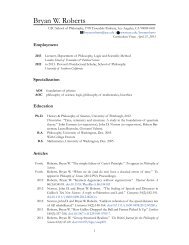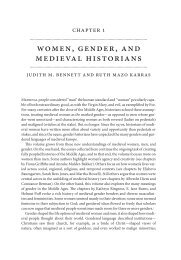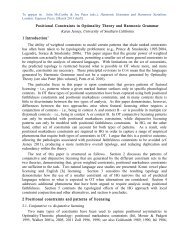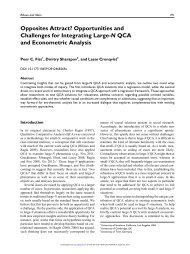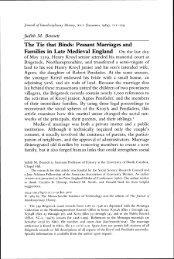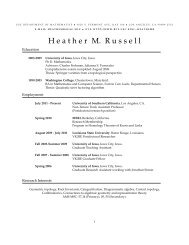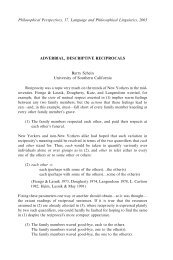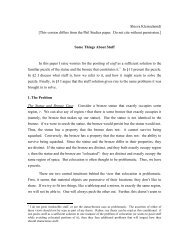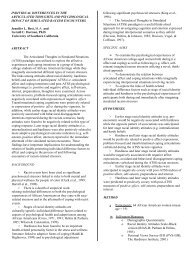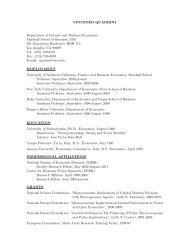The Racial Resegregation of Los Angeles County, 1940-2000
The Racial Resegregation of Los Angeles County, 1940-2000
The Racial Resegregation of Los Angeles County, 1940-2000
You also want an ePaper? Increase the reach of your titles
YUMPU automatically turns print PDFs into web optimized ePapers that Google loves.
county, for example, their ID would be 0 (perfectly integrated). If Blacks only lived in census<br />
tracts that were 100% Black, and no where else, then their ID score would be 1 (or 100% --<br />
perfectly segregated). Scores <strong>of</strong> 70% or higher are considered to show serious segregation.<br />
Blacks in U.S. cities have shown scores higher than this figure since the Second World War, and<br />
yet in many western cities this figure has come down significantly. Here in <strong>Los</strong> <strong>Angeles</strong> the ID<br />
for Blacks has decreased significantly from the very high 88% in 1960 and 1970 to the relatively<br />
moderate 57% in <strong>2000</strong>. Characterizing 57% as “moderate” is merely a relative judgment. It still<br />
means that 57% <strong>of</strong> all Blacks would need to move their place <strong>of</strong> residence in order to achieve<br />
perfectly even distribution across the county.<br />
Although the ID is important and useful, at least because it is so widely used, it is also a rather<br />
crude measure <strong>of</strong> segregation and needs to be supplemented with more nuanced measures. It is<br />
totally insensitive to actual and relative group population sizes, for instance. For example, Blacks<br />
in <strong>Los</strong> <strong>Angeles</strong> <strong>County</strong> might have the same ID score <strong>of</strong>, say, 57%, if there were only 10 Blacks<br />
in the county, 1,000 Blacks, or 1,000,000. It only tells us how many Blacks would have to move<br />
to even out the distribution, and it does not say anything about relative group sizes or their<br />
relative location.<br />
2.33 <strong>The</strong> Exposure Index<br />
<strong>The</strong> Exposure Index is the central tool used to evaluate trends in segregation in this study.<br />
<strong>The</strong> Exposure Index takes into account the relative sizes and locations <strong>of</strong> the various<br />
groups in the county and calculates the probability (ranging from 0% to 100%) that<br />
members <strong>of</strong> one group will have members <strong>of</strong> the other groups (or members <strong>of</strong> their own<br />
group) as neighbors. <strong>The</strong> unit <strong>of</strong> analysis is the census tract, which is taken to represent<br />
the “neighborhood.” <strong>The</strong> median tract population in <strong>Los</strong> <strong>Angeles</strong> <strong>County</strong> in <strong>2000</strong> was<br />
4,461; the average was 4,633. <strong>The</strong> “probability” <strong>of</strong> “exposure” then, is that a person will<br />
have a member <strong>of</strong> X group as a residential neighbor within their own census tract <strong>of</strong><br />
residence. <strong>The</strong> Exposure Index is a measure <strong>of</strong> residential segregation only. It does not<br />
measure the “exposure” <strong>of</strong> groups to one another in the workplace or in public places<br />
such as parks or shopping malls.<br />
<strong>The</strong> most powerful feature <strong>of</strong> the Exposure Index is that it is asymmetric. For example,<br />
Blacks in <strong>1940</strong> had a 45% chance <strong>of</strong> having White neighbors, but Whites only had a 1%<br />
chance <strong>of</strong> having a Black neighbor. Why this asymmetry? Whites (at 2.6 million in<br />
<strong>1940</strong>) vastly outnumbered Blacks (75,000 in that year) in <strong>Los</strong> <strong>Angeles</strong> <strong>County</strong>.<br />
Moreover, the vast majority <strong>of</strong> Whites lived in segregated neighborhoods in which<br />
Blacks were not permitted to live. Conversely a great many Whites lived in the<br />
neighborhoods segregated for nonwhite residence (very few tracts were more than 50%<br />
Black even in Jim Crow’s heyday). Thus, by virtue <strong>of</strong> the specific locational and<br />
proportional conditions <strong>of</strong> the county in <strong>1940</strong>, Blacks were “exposed” to Whites much<br />
more frequently than Whites were to Blacks, and a strong measure or segregation should<br />
tell us this.<br />
<strong>The</strong> very strength <strong>of</strong> the Exposure Index—that it allows us to see the segregation<br />
condition between more than one group at a time and from the different perspectives <strong>of</strong><br />
each <strong>of</strong> these groups, also leads to a confusing number <strong>of</strong> indexes: Between Blacks and<br />
Race Contours <strong>2000</strong> –<strong>Resegregation</strong> <strong>of</strong> <strong>Los</strong> <strong>Angeles</strong> <strong>County</strong>, <strong>1940</strong>-<strong>2000</strong> 6



